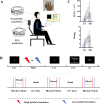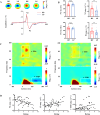The Investigation of the Relationship Between Individual Pain Perception, Brain Electrical Activity, and Facial Expression Based on Combined EEG and Facial EMG Analysis
- PMID: 39776765
- PMCID: PMC11705972
- DOI: 10.2147/JPR.S477658
The Investigation of the Relationship Between Individual Pain Perception, Brain Electrical Activity, and Facial Expression Based on Combined EEG and Facial EMG Analysis
Abstract
Purpose: Pain is a multidimensional, unpleasant emotional and sensory experience, and accurately assessing its intensity is crucial for effective management. However, individuals with cognitive impairments or language deficits may struggle to accurately report their pain. EEG provides insight into the neurological aspects of pain, while facial EMG captures the sensory and peripheral muscle responses. Our objective is to explore the relationship between individual pain perception, brain activity, and facial expressions through a combined analysis of EEG and facial EMG, aiming to provide an objective and multidimensional approach to pain assessment.
Methods: We investigated pain perception in response to electrical stimulation of the middle finger in 26 healthy subjects. The 32-channel EEG and 3-channel facial EMG signals were simultaneously recorded during a pain rating task. Group difference and correlation analysis were employed to investigate the relationship between individual pain perception, EEG, and facial EMG. The general linear model (GLM) was used for multidimensional pain assessment.
Results: The EEG analysis revealed that painful stimuli induced N2-P2 complex waveforms and gamma oscillations, with substantial variability in response to different stimuli. The facial EMG signals also demonstrated significant differences and variability correlated with subjective pain ratings. A combined analysis of EEG and facial EMG data using a general linear model indicated that both N2-P2 complex waveforms and the zygomatic muscle responses significantly contributed to pain assessment.
Conclusion: Facial EMG signals provide pain descriptions which are not sufficiently captured by EEG signals, and integrating both signals offers a more comprehensive understanding of pain perception. Our study underscores the potential of multimodal neurophysiological measurements in pain perception, offering a more comprehensive framework for evaluating pain.
Keywords: electroencephalogram; facial electromyogram; general linear model; multiple physiological signals; pain assessment.
© 2025 Ma et al.
Conflict of interest statement
The authors report no conflicts of interest in this work.
Figures



Similar articles
-
Decoding of the coupling between the brain and facial muscle reactions in auditory stimulation.Technol Health Care. 2022;30(4):859-868. doi: 10.3233/THC-213528. Technol Health Care. 2022. PMID: 34842201
-
Single channel approach for filtering electroencephalographic signals strongly contaminated with facial electromyography.Front Comput Neurosci. 2022 Jul 26;16:822987. doi: 10.3389/fncom.2022.822987. eCollection 2022. Front Comput Neurosci. 2022. PMID: 35959164 Free PMC article.
-
Improving EEG Muscle Artifact Removal With an EMG Array.IEEE Trans Instrum Meas. 2020 Mar;69(3):815-824. doi: 10.1109/tim.2019.2906967. Epub 2019 May 1. IEEE Trans Instrum Meas. 2020. PMID: 32205896 Free PMC article.
-
Integrated Biosignal Analysis to Provide Biomarkers for Recognizing Time Perception Difficulties.J Med Signals Sens. 2023 Jul 12;13(3):217-223. doi: 10.4103/jmss.jmss_24_22. eCollection 2023 Jul-Sep. J Med Signals Sens. 2023. PMID: 37622046 Free PMC article.
-
Brain (EEG) and muscle (EMG) activity related to 3D sit-to-stand kinematics in healthy adults and in central neurological pathology - A systematic review.Gait Posture. 2024 Sep;113:374-397. doi: 10.1016/j.gaitpost.2024.07.010. Epub 2024 Jul 17. Gait Posture. 2024. PMID: 39068871
References
-
- Gruss S, Geiger M, Werner P, et al. Multi-modal signals for analyzing pain responses to thermal and electrical stimuli. JoVE. 2019;146:e59057. - PubMed
LinkOut - more resources
Full Text Sources

